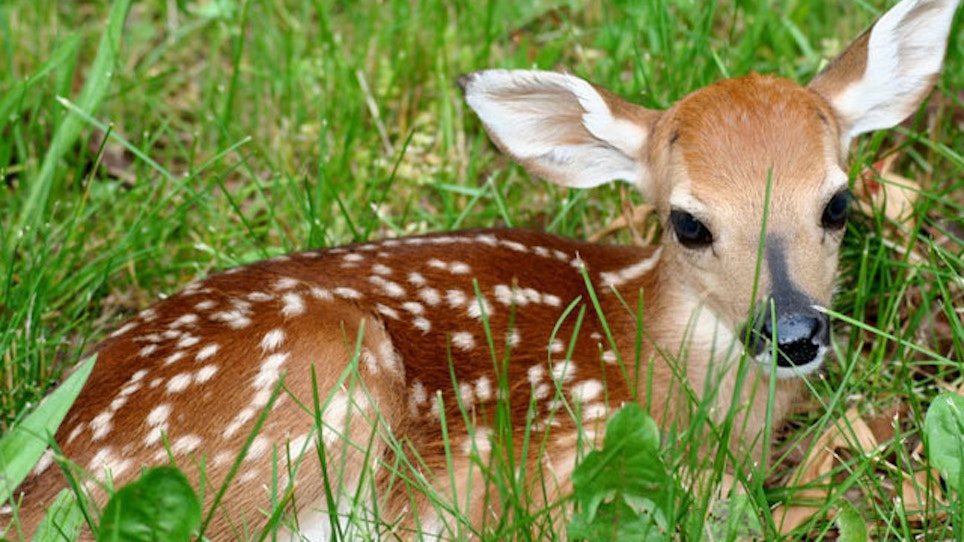By NICK LOWREY | Pierre Capital Journal
PIERRE, S.D. (AP) — The fawn leapt from a thicket of sweet clover bounding into a shallow draw, its trademark white tail pointed to the sky as it tried to escape.
In a diving tackle South Dakota Game, Fish and Parks biologist Nathan Baker grabbed hold of the fawn's back legs and tumbled down the hill a few extra feet. A few seconds later he stood up with an obviously terrified, though no worse for the wear, week old white-tailed deer fawn. Baker was winded, red-faced and smiling ear to ear - whitetails can be tough to catch.
The fawn, a young buck as it turned out, was caught June 10 and was about to become part of a new study aimed at developing a better understanding of how South Dakota's deer population grows.
The last 15 years or so have been a rollercoaster ride for the state's deer hunters. Deer numbers in the early 2000s led biologists to start a record breaking program aimed at shrinking the herd. An enormous number of deer tags were issued, licenses with three tags were common. The yearly deer harvest record was broken several times.
“We've all gotten kind of used to a high number of tags,” said Andy Lindbloom, Game, Fish and Parks' senior big game biologist. “The availability of licenses has just been incredible.”
Then, starting in 2009, a series of bad winters and drought filled summers began to take an enormous toll on deer. In each of the last three years, the number of deer tags has been drastically reduced. From 2013 to 2014, the number of deer licenses issued dropped by 22 percent in east river hunting units, and west river licenses dropped by 17 percent, and tags by a whopping 56 percent.
“What we're seeing is its getting back to the norm now,” Lindbloom said.
Biologists can't stop bad weather, but they can find better ways to account for how it, as well as predation and disease, affect the deer herd. And that is the whole point behind sending biologists such as Baker out to catch fawns.
The information they collect will provide game managers with a better population estimate and a better idea of how the population will grow in the next year.
“Probably the most important thing is it helps us determine the trend.” Lindbloom said. “Whether it's going up or down.”
Knowing, or at least having a pretty good idea of the direction the deer population is headed, is critical because Game, Fish and Parks biologists use that information to help set the number of deer licenses that will be issued every year.
“This is one piece that helps us determine that,” Baker said.
To that end, Game, Fish and Parks has designated five study areas across the state, in which both does and fawns are captured and fitted with radio collars. Biologists already have a pretty good idea of adult doe survivorship, what they don't know is how many fawns, on average, survive their first year. That is where this new study will be most useful.
“The primary purpose is to figure out what's affecting fawn recruitment,” Baker said.
So far, biologists have captured 271 fawns, 181 whitetail deer and 89 mule deer, Lindbloom said. Whitetail deer make up most of the study because they account for about 85 percent of the state's deer harvest, Lindbloom said.
Catching those fawns takes a lot of work. Baker will often spend most of an afternoon driving through his study area, the Fort Pierre National Grassland, looking for deer with the help of an airborne observer who spots does with fawns for him.
The young buck Baker captured June 10 was spotted about half a mile from any trail and he had to hike to it, which given the nature of his work, is fairly common. Once in hand, the fawn was weighed, measured and fitted with a spiffy new expandable radio collar.
“It's a lot like duck banding,” Baker said. “It's basically like a banding study.”
For the next year, if he survives that long, Baker will track the fawn along with all the other collared fawns in the study area to determine how many survive their first six months and how many make it to one year. If a hunter harvests one of the fawns they can call the phone number on the collar to report the kill and return the collar.
If the fawn dies Baker will try to figure out what caused the death. So far he's found that a fawn's first few weeks and months are by far its most dangerous. Though he doesn't have firm numbers yet, a significant portion of the fawns Baker tracks simply don't make it.
For the most part, knowing for sure what caused the death is difficult. Predation is probably the most common cause of death, but even that is hard to know for sure.
“It's not really obvious unless you see it,” Baker said.
The survival rate information Baker and his fellow biologists gather will make Game, Fish and Parks' annual population estimates much more accurate. Ultimately, the hope is to be able to act more quickly to reduce tag numbers when severe weather conditions or disease threaten deer numbers, Lindbloom said.
“It's going to be some of the best information we've had,” Lindbloom said.
———
Information from: Pierre Capital Journal, www.capjournal.com






